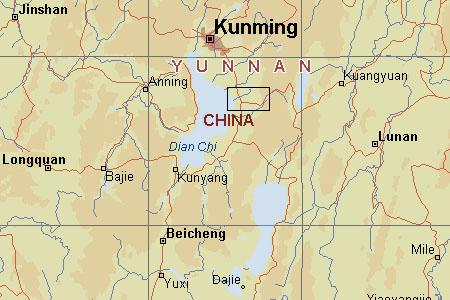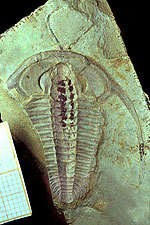
| Palaeos: |  |
Cambrian |
| Paleozoic Era | Chengjiang |
| Page Back | Up: Cambrian Sites | Unit Home |
| Page Next | Timescale |
Lower Cambrian soft-tissue fossils from Chengjiang, near the city of Kunming in Yunnan Province, China, preserve a diverse biota dated approximately 515 to 520 Ma, some 25 Ma after the beginning of the Cambrian and pre-dating the Middle Cambrian Burgess Shale by perhaps 10 to 15 Ma (Martin et al. 2000), and thus encoding an early record of the Cambrian Explosion.
The - - ied fossils include "diverse algae, medusiform metazoans,
chondrophorines, sponges, chancelloriids, sea anemones, priapulid worms, hyoliths,
possible ectoprocts, inarticulate brachiopods, annelid-like animals, lobopodians,
trilobites and non-trilobitic
arthropods, hemichordates and probable earliest
chordates as
well as taxa that cannot definitely be assigned to any well established groups" (![]() International
Subcommission on Cambrian Stratigraphy).
International
Subcommission on Cambrian Stratigraphy).
The fossils occur in rocks of the Qiongzhusi Formation, cropping out at Maotianshan near Chengjiang, Yunnan Province, South China (fig. 1) where they were accidentally discovered in 1984.
The fauna derives from the long-known Qiongzhusi Formation (syn. "Chiungchussu") of the Qiongzhusi Stage of the late Early Cambrian.
The sediments are finely laminated mudstones, formed in an outer shelf detrital belt, in quiet water environments. The frequency of macrobenthos suggests that the water was relatively well oxygenated, although bioturbation is sparse so that possibly only the uppermost layer at the sediment surface was oxygenated.
The preservation of non-mineralized organismal parts probably resulted from repeated rapid burial events that prevented the bodies from destruction by currents, bioturbation and other biotic activities such as by scavengers and carnivores. Burial is also thought responsible for absence of sulphate reduction which apparently was low so that the soft-parts were preserved in a number of different layers in the formation. Well developed anoxic conditions are reflected by several layers with carbon-rich deposits in the Qiongzhusi Formation. These conditions probably led to frequent mass mortalities which may have played a significant role in the soft-part preservation.

The Chengjiang biota occurs about 25 m above the earliest trilobites (genus Parabadiella) found in this area and on the Yangtze Platform (which are most probably coeval to late Atdabanian trilobites of the Siberian Platform).
Perhaps the most surprising aspect of the Chengjiang biota is the wealth of taxa from so many different groups. The fossil assemblages includes diverse algae, medusiform metazoans, chondrophorines, sponges, chancelloriids, sea anemones, priapulid worms, hyoliths, possible ectoprocts, inarticulate brachiopods, annelid-like animals, lobopodians, trilobites and non-trilobitic arthropods, hemichordates and probable earliest chordates as well as taxa that cannot definitely be assigned to any well established groups.
It is not only the diversity and early appearance in the fossil record which makes the Chengjiang assemblage fabulous, but also the fine preservation which offers the opportunity to learn more about the morphology of these early creatures. One of the most outstanding examples might be Microdictyon, the isolated sclerites of which were known from numerous localities on various continents, but none of the specialists had any idea how this creature could have been organized. The discovery of these net-like scales of Microdictyon on a worm-like animal resolved the question.
Sponges are a major component in Lower Cambrian Chengjiang fauna, where they are second
only to arthropods in both generic and specific diversity. About 1000 sponge body fossils,
distributed among 15 genera and 30 species, have been collected there. The skeletons in
most species are represented exclusively by
diactines, which form a regular, reticulate
skeletal framework. The dermal reticulate organization of spicules is common in the
Chengjiang fauna, and these fossils are classified as demosponges. The data from
Chengjiang fauna demonstrate that main clade of early sponges, the
monaxonid Demospongiae
was diverse in the Lower Cambrian. We thus suggest that diactines evolved before other
types of spicules. The keratosal demosponges that have skeletons composed entirely of
spongin fibers, are seen first in the Lower Cambrian in Chengjiang fauna (Li et al.
1998)
Eoredlichia intermedia

"In 1912, Charles D. Walcott erected the Family Waptiidae to accommodate Waptia fieldensis, a still poorly understood bivalved arthropod from the Middle Cambrian Burgess Shale of British Columbia, Canada. Several other bivalved arthropods seemingly similar to Waptia have since been discovered, such as the Lower Cambrian taxa Pauloterminus spinodorsalis (nomen nudum) from the Sirius Passet fauna of North Greenland and Chuandianella ovata from the Chengjiang fauna of southwest China.
"Despite their overall waptiid-like appearance, however, each of these animals possesses features which suggest their apparent similarity to Waptia fieldensis may be superficial. Variability in segment number, limb number and limb type between these taxa, for example, suggests these animals may not in fact be closely related.
"Other non-waptiid Cambrian arthropods also possess bivalved carapaces, including the Burgess Shale taxa Canadaspis perfecta and Plenocaris plena. This indicates two alternative evolutionary scenarios. First, the relatively common occurrence of bivalved carapaces may indicate a stem-group clade of bivalved arthropods in the Cambrian, united (at least) by their possession of this specialized carapace. A second, perhaps more likely, possibility is the occurrence of evolutionary convergence, resulting in the presence of a bivalved carapace in multiple unrelated Cambrian arthropod taxa."
Chen et
al. (1999)
The first fossil chordates are found in deposits from the Cambrian period (545-490 million
years ago), but their earliest record is exceptionally sporadic and is often
controversial. Accordingly, it has been difficult to construct a coherent phylogenetic
synthesis for the basal chordates. Until now, the available - ied remains have
consisted almost entirely of cephalochordate-like animals from Burgess Shale-type faunas.
Definite examples of jawless fish do not occur until the Lower Ordovician (475 Myr BP),
with a more questionable record extending into the Cambrian. The discovery of two distinct
types of craniate-like
chordates from the Lower Cambrian Chengjiang fossil-Lagerstätte is, therefore, a
very significant extension of their range. One form is lamprey-like, whereas the other is
closer to the more primitive hagfish. These finds imply that the first
fishes may have evolved in the
earliest Cambrian, with the chordates arising from more primitive deuterostomes in
Ediacaran times (latest Neoproterozoic, 555 Ma), if not earlier.
| Links |
![]() International Subcommission on Cambrian Stratigraphy
International Subcommission on Cambrian Stratigraphy
![]()
![]() Chengjiang Maotianshan Shales Fossils
Chengjiang Maotianshan Shales Fossils
| References |
Grotzinger, J.P.; Bowring, Samuel A.; Saylor, Beverly Z.; Kaufman, Alan J. (1995): Biostratigraphic and Geochronologic Constraints on Early Animal Evolution. Science, 270: 598-604.
Li, Chia-Wei; Chen, Jun-Yuan; Hua, Tzu-En (1998): Precambrian Sponges with Cellular Structures. Science v. 279, issue of 6 February 1998, pp. 879 - 882.
Martin, M.W.; Grazhdankin, D.V.; Bowring, S.A.; Evans, D.A.D.; Fedonkin, M.A.; Kirschvink, J.L. (2000): Age of Neoproterozoic Bilaterian Body and Trace Fossils, White Sea, Russia: Implications for Metazoan Evolution. Science v.288: 841-845.
Shu, D-G.; Luo, H-L.; Conway Morris, S.; Zhang, X-L.; Hu, S-X.; Chen, L.; Han, J.; Zhu, M.; Li, Y.; Chen, L-Z. (1999): Lower Cambrian Vertebrates from South China. Nature 402: 42-46.
Taylor, Rod S. (1999): 'Waptiid' Arthropods and the Significance of Bivalved Carapaces in the Lower Cambrian. Palaeontological Association 44th Annual Meeting, University of Edinburgh, 17-20 December 1999 (Oral Presentation)
| Page Back | Page Up | Page Top | Page Next |